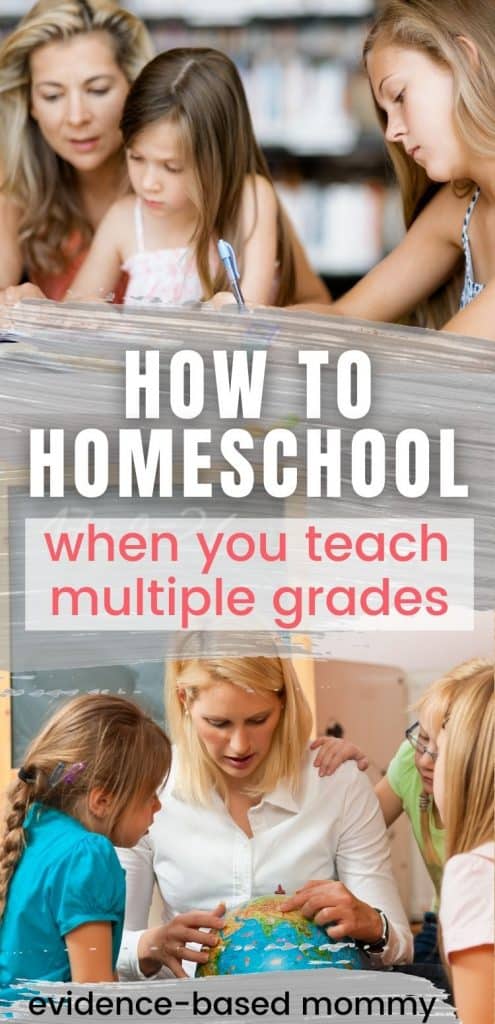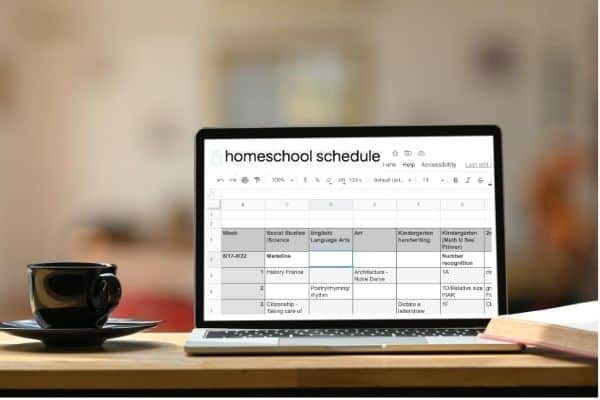Whether you’re homeschooling or doing online school from home, having more than one child complicates things. Most likely, you’re homeschooling multiple grade levels together. And keeping a toddler entertained while you homeschool makes things even more difficult.
I’ll be honest: I thought long and hard before I made the leap to homeschool. Even though I successfully taught college-level chemistry for about a decade, I was really nervous to homeschool a kindergartner and second grader.
Fortunately, the teaching skills I learned in the workforce are transferable! So even though I’m teaching all the subjects now instead of just chemistry, and I’m teaching a 5 year old and a 7 year old instead of a whole room of 18-20 year olds, things are going really well.

I thought it might help you to hear how I organize homeschooling throughout the day. So if you’re new to homeschooling, here are some tips to make it easier (especially if you’re teaching multiple grade levels).
Table of Contents
Find or create appropriate goals and objectives for each child
When I taught at our local university, I was required to create a syllabus (for each course) detailing my goals and objectives for the entire semester. And one of the primary parts of my syllabus was to define goals and objectives for the school year ahead.
While it may sound intimidating, having a “big picture” view for your school year really helps you plan what to do on a day-to-day level.
Check out your state’s requirements for which subjects to cover, and then find a set of objectives for each grade level (here is an example for kindergarten, and another for 2nd grade). Don’t try to reinvent the wheel here – just use someone else’s ideas (preferably ones created by an early child educator).
Don’t be afraid to use two different math curricula based on your children’s personalities
You know your kids best. They each have their own needs, their own personalities, and their own thinking styles. What works for one child may not work for another, and this is especially true with math.
If you’ve ever tried to choose a math curriculum, you know how overwhelming all the choices can be (this is an excellent review from an actual math educator on your options). For example, my younger daughter is a bit more of a concrete thinker, so I chose Math U See for her. My 2nd grader is a bit more comfortable with thinking abstractly, so we chose Singapore Math for her. As they get older, we may switch, but this is working well for now.
Plan ahead for school
Once you have an overarching plan, it’s time to think about how you’re going to set up your kid’s day-to-day. Especially if you’re homeschooling and using curriculum from multiple textbooks, it’s essential to have a game plan. Not only will this save you a ton of stress, it will help you make sure you cover all your learning objectives for each child.

You don’t necessarily have to cover each subject every day, but you’ll want to hit everything at least a few times a week. Math and some form of reading or writing should be covered pretty much every day (it’s okay if you miss every once in a while) because they require the most consistent practice to hone skills. For elementary school, you can hit science, social studies, music and art just a time or two a week.
How to make a homeschool schedule
Basically, you’ll want to look at your curriculum and figure out pacing. If you have a math textbook, you might cover one “lesson” or “chapter” a week.
You might choose to do “unit studies,” where you cover one subject or story in depth for a week. I’m using Five in a Row for everything but math, handwriting, and phonics. There’s 19 books covered in each FIAR Volume, so I figure I can either buy the second volume midway through the school year or go back to some favorite books and pull different lessons from them.
My suggestion is to go out at least a month in advance for your plans. Think about holidays you want to emphasize (and observe – build breaks in!), weather, and opportunities for field trips.
From there, you just need to schedule math, phonics, and/or spelling. Again, look at the book to figure out pacing.
For my kindergartner, we’re using Math U See, and there’s 30 lessons in the Primer level. I figure there’s roughly 36 weeks in the school year (180 school days / 5 days per week), so I plan to do about one lesson per week with a review break every 6 weeks or so (wherever is logical). Note this means you don’t have to use every single worksheet! Don’t feel obligated to do every single activity in a text.
Handwriting is easier to figure out – just do a page or two of your workbook a day. Older learners can fold handwriting into other writing assignments.
You’re not married to your schedule, but having a simple spreadsheet helps you make sure you’re covering each subject on a regular basis.
Fold multiple subjects together
It might feel like you have a ton of subjects to cover, and school work can quickly become overwhelming for you and your kids. Fortunately, you can easily combine subjects.
If you’re talking about citizenship or the postal service for example, use the opportunity to have your child write a letter to someone and address an envelope (younger learners can dictate their letter to you and then draw a picture to go with it). Bam – social studies and English / Language Arts done.
If you’re learning about inventors, give your kids the chance to create something (and to try again when their invention doesn’t work well the first time). You’ve just hit history and science simultaneously.
With a little creativity and practice, you can make writing assignments more fun and meaningful by connecting them to other parts of your child’s schooling.
Combine science and social studies across grade levels
Kids only a few years apart will do fine doing some less core subjects together. While your 1st and 3rd grader are likely not doing the same math, they can still both do a chemistry lesson with a baking soda and vinegar volcano. Combining lessons can streamline subjects like science, social studies, and art. Even the same language arts concepts can be taught to two different ages – one child may write a short story, while a younger one dictates her story to you and then illustrates it.

If you’re worried about how much depth to go into when teaching two kids at two different grade levels the same thing, just teach to the higher grade student. Make sure you address both kids when discussing, and your younger child will still pick up a lot of info.
Have one child work while you explain a concept to the other
When you’re homeschooling two different grade levels at once, there are definitely subjects such as math or reading that you’ll have to teach at two different levels. Your children will each be using two different math books and be practicing different sets of skills. But you can do this!

Set up one child (preferably, the one with the easiest lesson to explain), and then turn him loose to work. While that child is working, then teach your other child what they need to complete their work.
Use coloring to fill time
Regardless if your children are working on two different things or on the same lesson, one is bound to complete his work before the other. You’ll need to keep the finished one on task so he doesn’t interrupt his sibling.
If you have younger learners, don’t underestimate the value of coloring. Often, my second grader will need additional instruction on math while my kindergartener is already done with her work. Letting my younger child color her worksheet while I teach the older one gives me extra time (and makes my kindergartner happy).
How to stay organized for homeschool
There’s not much more stressful than wanting to start school for the day and not being able to find what you need. It makes things much easier to have a special place to do schoolwork.

Ideally, have a designated homeschool workspace. Keep essentials like pencils, paper, and any workbooks there, and don’t move them or let them be used for crafting outside of school time. Math manipulatives should be kept in a box in this area as well.
If you don’t have room for a special classroom, no problem. Just use the kitchen table or counter for your workspace. Keep a shelf or cabinet reserved for school materials, and put them away (preferably out of reach of younger siblings!) at the end of the class day.
How to keep younger kids occupied during homeschool
If you’re homeschooling two kids in two different grades plus a toddler or preschooler, that just adds to the challenge. Fortunately, there’s several ways to work in your younger children.
Make younger siblings feel special when homeschooling
If you have a toddler or preschooler who isn’t officially in school yet, but is interested in what older siblings are doing, give him something that he can call his own. I found an extra composition book and put my 3 year old’s name on it. He colors in it for at least 15-30 minutes, letting me pack in lesson time.

You can also make sure to have special toys available for your toddler just during school time. Fortunately, I have whole lists of quiet, battery-free toys for toddlers and preschoolers you can check out.
RELATED: The best battery-free toys for toddlers
RELATED: Battery-free toy guide for preschoolers
Work around nap times
If your toddler just won’t cooperate with letting you teach without interruption, that’s okay! If he is still taking naps, use this time to your advantage. You can let everyone play in the morning, and then pack as much school as you and your older kids can handle during nap time.
Don’t forget free play outside
Kids need time to play outside to reset their bodies and minds back into learning mode. Free play, where they choose what to do themselves, is the best way to give them a break (plus, it counts for physical education!).

Don’t worry about teaching your kids to dribble a basketball or making them run laps, just let them go outside and play however they want. These activities make them less fidgety during learning time and help them pay attention.
Conclusions on homeschooling tips for multiple grades
If you’re homeschooling more than one kid, you’ll need to do a little extra work to pull it off. Fortunately, with a little planning, teaching two kids in different grades is totally doable.
